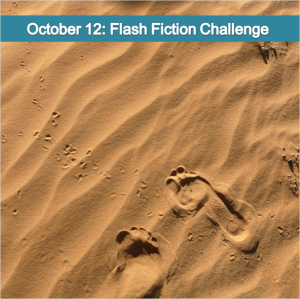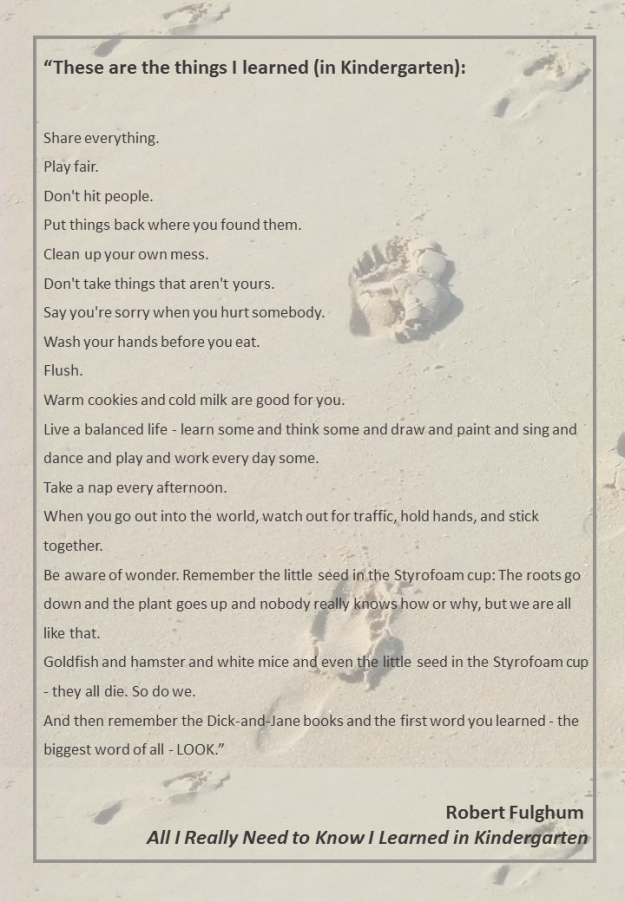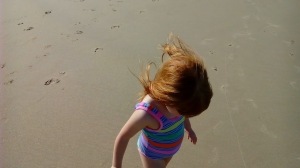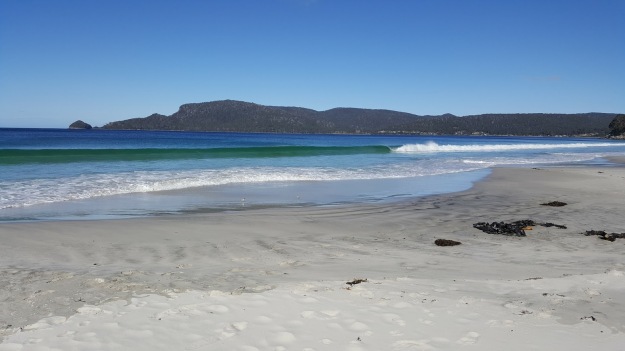I grew up near the beach (but sadly not the one pictured) and my siblings and I would spend many long hours playing on the cliffs, climbing the trees, and splashing in the water. Sometimes we’d even lie on the sand and sunbake. Most of us are paying for it now as our fair skin, even with sunscreen, or without as it was then, was not designed for the hot Queensland sun.
One of the nicest things to do was to stand at the water’s edge as the waves receded, and feel the sand withdraw from beneath my feet, leaving me standing in hollows. If I stood there through successive comings and goings of waves, I could end up standing in quite large holes. The meditative effect was calming and reassuring, placing me firmly in nature.

© Norah Colvin
Of course, the beach is not the only place that sand can be found. There are the hot red sands of Central Australia; and of Utah, where Charli Mills has recently relocated.

© Charli Mills
There are the cruel sands of time that flow too fast and can’t be upturned for a do-over.

But these sands are not the focus of my post. I am thinking of the sandpits, or sandboxes, common to playgrounds for young children in early learning centres, schools, and parks. I would probably not be taking much of a risk if I were to suggest that most of you played in a sandpit when you were young. Maybe you were involved in an accident of some sort: getting sand in your eye or hit by a spade, possibly fighting over a toy.
There are many friendship lessons to be learned when playing in the sandpit, even if playing alongside, rather than with, others:
- Play nicely
- Share
- Take turns
- Cooperate
- Sand stays in the sandpit: it’s for digging, filling, building, and sifting; but not throwing.
Sandpits are generally popular during lunch breaks at school, particularly if suitable toys and implements are available. I have seen groups of children spend successive lunch times building roads, cities, and rivers; working together constructively in ways we only dream of in our artificially designed group-work activities. The fluidity of the group ensures that fresh ideas are always available; and sees some suggestions implemented, and others discarded.
But the sandpit is not just for playtime and recess. Utilising it during class time provides a welcome break from the indoors. There is nothing like a bit of physical activity in the fresh air to awaken the brain cells and stimulate thinking. While opportunities for free play may offer the best of learning experiences for children, I’m providing a few suggestions in case justification of something more academic is ever required.
Introduce each sandpit session with some tactile experiences. It cannot be taken for granted that all children have experienced sand play and may be unfamiliar with how it feels underfoot, to walk on, or hold in their hands. Also, having a bit of play in the beginning will help the children concentrate as the lesson progresses.
It is also a good idea to set some rules for sand play. Ask the children, they probably know best.
Experiencing sand
Have everyone remove their shoes and socks and stand in the sand, then ask them to (for example):
- twist on the spot, feeling their feet dig into the sand
- wriggle their toes, feeling the sand squish between them
- stamp their feet, noticing the difference from concrete, or grass
- sit at the edge, stretch out their legs, and push their feet under the sand, then slowly lift them up, letting the sand slowly fall off
- pick up handfuls of sand and then let it slowly fall through their fingers
- pick up handfuls of sand, bring their hands together, then rub them together as they watch the sand slowly fall
Counting
Have children sit around the edge and count the number of children (in ones), feet and hands (in twos), fingers and toes (in fives, and the tens)
Pouring and measuring volume
Ask children to estimate and measure; for example:
- How many of these containers does it take to fill that one?
- How many of these containers can I fill from that one?
- Which container holds more?
Digging for buried treasure
Hide items in the sandpit for children to find. They may need to find a certain number, follow clues, or understand a grid. It could even be set up like a battleship game with children hiding and guessing the placement of toys in the sand.
Measuring length
Have children use arbitrary units to measure the width or length of the sandpit; for example: using feet, hands, blocks, containers.
Recognising shapes
Have children look for shapes in the construction of the sandpit and other playground equipment. Have them draw shapes in the sand.
Creating artworks
Have children draw a picture or pattern with glue on a heavy piece of card then sprinkle with sand. Mix in some powder paint to add colour.
Of course, there is nothing better than giving them time to play and conduct their own learning: talking, negotiating, planning, and problem solving. Although I wouldn’t go so far as to say that everything one needs to learn could be learned in a sandpit, it’s probably not too far from the truth.
The title of a book written by Robert L. Fulgham and published in 1988 declares All I Really Need to Know I Learned in Kindergarten: Uncommon Thoughts on Common Things. Surprisingly, I must confess to not having read it, but the words have infiltrated society and become an oft-repeated adage. I feel as if I have read it, and agree with the simplicity of the truth it espouses.
Fulgham writes:

According to Lessons from the Sandbox written by Patricia Leigh Brown and published in the New York Times in 1989, the book was almost an accident. I could carry the link a little further and suggest perhaps, an accident occurring in the sandpit. The story of its publication and success should give a writer heart. We can never predict how a story will develop, let alone end.
This week at the Carrot Ranch, Charli Mills has challenged writers to In 99 words (no more, no less) write a story about a walk across the sand. This is my response. I hope you enjoy it.

© Norah Colvin
Building sandcastles
The sun shone. A gentle breeze kissed the children’s cheeks, cooling them, as they shared the bucket and spade to build castles and dig moats. She gathered shells and seaweed for decoration. He filled the moat. Parents smiled, satisfied.
Suddenly, he jumped onto the castle, gleefully twisting from side to side. She protested; she’d not finished. He laughed. She cast aside the last of her ornaments and stomped away. He shrugged.
Remorseful, he went after her, “Wait. I’m sorry. Let’s build it again.”
“Really?”
“But make it bigger this time.”
Hand in hand they raced back to start again.

Thank you for reading. I appreciate your feedback. Please share your thoughts.



So many great learning ideas for the sandpit! It’s so much more than just another toy. My fondest memory was creating the dinosaur world in the sandpit when I was a kid. Thanks for sharing!
LikeLiked by 1 person
That dinosaur world with active volcanoes was a lot of fun. I remember it too!
LikeLiked by 1 person
When we are younger we seem so free… I used to go to the (New) Jersey shore (shore just another word for beach…why is it different? Who knows?). There seems to be a different tempo when we are near the pull of the ebbing tides.
I am looking forward to walking in warm sand again eventually…locally or not so local. 😉
LikeLiked by 1 person
I think of the shore as the place where the ocean meets the land. It’s not always a beach. That’s my guess. Now I’m going to Google it to see. Yep. Google agrees with me. I searched for ‘difference between shore and beach’.
I hope you do get to walk on a beach sometime soon. It does make a difference to life’s flow.
LikeLiked by 1 person
I do have the shore of my creek…but there is no sand… just mud. There was an article that I read somewhere about New Jersey using the word shore for beach, but it didn’t really explain anything. In New Jersey the shore is the beach. And that’s just one way to tell who the tourists are 😉
LikeLiked by 1 person
Or maybe who the locals are! 🙂
LikeLiked by 1 person
There is that ‘Jersey’ ‘accent’… that the actress Fran Drescher sort of made famous … Though not everyone in New Jersey has that ‘nasal’ pronunciation. 🙂
LikeLiked by 1 person
Are you from New Jersey? Is that your accent?
LikeLiked by 1 person
I lived in New Jersey for about ten years – I don’t have ‘an accent’ like Fran. However that said…I also don’t have a Southern drawl, a Texas Twang or one from the ‘like’ the West Coast either – having mostly resided in the North Eastern parts of the US. (NY, NJ and PA, all Northeastern states. Though I also lived about ten years in a ‘central region’ state. And I really don’t count the very few early years I lived in the southern region – since I’ve more or less acclimated to the north. 😉
LikeLiked by 1 person
You have certainly done a bit of moving around. I guess you’d have to have a fairly “normal” accent.
LikeLiked by 1 person
Where ever you go if you aren’t local you’ve got some regional ‘accent’. 🙂
LikeLiked by 1 person
That’s true! 🙂
LikeLiked by 1 person
Pingback: Walk Across the Sand « Carrot Ranch Communications
OH if only… “sands of time that flow too fast and can’t be upturned for a do-over.”
One is never too old to play in the sand. Especially making sand art or finding buried treasures in the sand. Though I do just love the soft, warm, forgiving feeling of sand under my feet. So grounding. 🙂
I don’t remember playing in sandboxes (though I probably did) but more at lakes and beaches.
LikeLiked by 1 person
I was way off with my prediction that most would have played in sand boxes. That will teach me for making assumptions. I would have played in sand more at the beach myself. I guess my children, with less access to the beach, played in sandboxes more.
Sand art and sculptures are amazing; and building them almost mesmerising. Thanks for joining in the conversation.
LikeLiked by 1 person
Strange as it may seem, one of the things I dislike the most is the feel of sand on my bare skin, Norah. We live 5 minutes from the beach, but I always cover up really well when walking along it with the dog. He seems to love rolling around in it, but ever since I was a child I disliked the feel of sand. Whenever the slightest bit of sand got stuck to me I’d scream my head off and try all I could to brush it off. We had a sandpit, but also a large water bath which was up off the ground and could be wheeled in/out of the shed or garage. It was the same size as a sandpit and I would happily spend hours filling up containers, water pistols or use an old washing up liquid bottle to squirt water at my unsuspecting sister in the sandpit. 😃 The water fascinated me, even though I was never able to learn how to swim.
LikeLiked by 1 person
There are many who don’t enjoy the tactile experience of sand. While I didn’t say so in the post, it is one thing teachers need to be mindful of and not force children if they are reluctant. I think a lot of different experiences in the early years helps to overcome some of the reluctance, but there are many reasons for such a dislike. As with everything else, we need to respect individuals. Thanks for sharing your experiences. How lovely to live five minutes from the beach and go for daily walks. The water is probably too cold to swim, so it’s not surprising you never learnt, no matter how much you enjoyed playing in the water and squirting your sister with the water bottles – just making assumptions! Thanks for sharing. 🙂
LikeLiked by 1 person
Oh, we had an indoor heated swimming pool at school, Norah. However, I was terrible at trying to coordinate my arms and legs at the same time when in the water. I also feared my head going under and being pulled down by the water. Not surprising if I also tell you that i don’t like going on boats.
LikeLiked by 1 person
Indoor swimming pools! I should have thought of that. There are not so many of them here! 🙂 I think a fear of water is based on genuine dangers. It’s not a bad thing to be aware of the risks involved.
LikeLiked by 1 person
Thank you Norah, brings back good memories. I learned a lot in my sandbox. Not many sandboxes around now. Not sanitary enough. That’s a whole other story.
LikeLiked by 1 person
Thank you, Dayne. I’m pleased the post stimulated some pleasant memories. Sandpits are still quite common here. They do need to be covered when not in use to keep the wildlife out. Is that what you were referring to, or something else?
LikeLike
Buckets and buckets of good sand in your post, Norah. I imagine a wild and rambling childhood for you on the coast. I did not have sandpits in school and it seems that most parks I recall taking my children to had gravel rather than sand. My eldest and her husband live along Lake Superior and both love building (and destroying) sand castles. Your flash explores how children develop social skills in the sand pit. Lovely!
LikeLiked by 1 person
Thank you for your encouraging comment, Charli. I don’t imagine the gravel was for playing in! Though children do like to play with stones. However, they’re generally considered unsafe for play – gravel rashes if falling and injuries if thrown. Living along Lake Superior sounds amazing. I’m pleased to hear your young ones are still young at heart and enjoying life. 🙂
LikeLike
Your story captures a sentimental memory – I’m sure we’ve all done this! Lovely 😊
LikeLiked by 2 people
Thank you, Jenny. I appreciate your comment.
LikeLiked by 1 person
What a great post filled with wonderful teaching ideas!
LikeLiked by 1 person
Thank you, Tara. I appreciate your comment.
LikeLike
I always enjoyed sandpits both as a child and a parent. You are right in that they are infinitely flexible in encouraging imagination. You flash contains a neat lesson
LikeLiked by 2 people
Thanks, Geoff. I’m pleased you enjoyed it.
LikeLiked by 1 person
Gosh Norah, it’s like you are living in my house secretly….. just last night I was talking about it being nearly time to wander down to the beach and dig my toes into the sand and feel that tug of the water dragging the sand from beneath my feet. It’s one of the pleasures of summer time – and you are never too old to enjoy it! And I’m with you too on the Fulghum thing – I guess thanks to the internet these days we can all become aware of these life lists – I remember we had this one on the staffroom wall for a while along with some other thoughtful, historical and plain hilarious life hacks. I still have not read this book, though I admire Mr Fulghum very much! I had the same reaction as Anne to your story – isn’t it interesting how we respond to damaging or destroying a creation – it takes courage to understand that the lessons learned can be reapplied and something even better may arise. I still have these moments when working on paintings and applying layers!
LikeLiked by 2 people
Thank you for your lovely comment, Pauline. I’d love to stand at the water’s edge with you and feel that sand being pulled away from under our feet. One day. 🙂
I think the quote would be perfect for a staffroom.
I have just started to read a book called “A Learner’s Paradise” about education in New Zealand. It is just a new book so you may not be aware of it since you are avoiding schoolish things now in your retirement, but I think of you when I read it. The author Richard Wells says that NZ has the best education system in the world. I’m looking forward to finding out what about it he thinks is so good. 🙂
It’s true too, that sometimes we need to destroy things for something better to arise (I’m thinking our education system!)
LikeLike
Ha! Norah, the first thought that arose in my mind was ‘who is paying him?’ Isn’t that dreadful! The second thought is, well the rest of the world must be in a really bad way! I’ve heard so often recently that Finland has the best education system in the world – I guess it all depends on what platform you base ‘education’ on. Please let me know what you think when you have finished reading the book – or before, if you realise it is a con job 🙂
LikeLiked by 1 person
It sounds pretty good to me. I think it’s probably been a change in the last 10 years or so. I always admired Sylvia Ashton Warner and Marie Clay, two eminent NZ educators. I think you’d like what he’s saying. You might refute his evidence, though I hope not. 🙂
LikeLike
Yes, those were two great women who fought hard to get their ideas and their wisdom accepted and education in general benefited from their work. I’m not involved any more as you so rightly point out – nor am I wanting to raise my blood pressure by becoming involved. 🙂 Though on a daily basis I see children who are bored and under challenged at school. I live not far from a combined primary/intermediate school [a result of the last cost cutting ventures that saw several local primary schools shut down due to ‘falling roles’ ie classes under 30 students.] I’m very unimpressed by the outdoor activities I witness, the attitudes of the students and the lack of teacher involvement in any meaningful way.
It comes back again to what the platform is I think. Is ‘education’ something that is done to children so those who are capable can rise through the academic levels and ‘succeed’ and those who aren’t get menial jobs or no jobs at all. Or is it education that opens students minds and hearts and teaches them how to learn so that they want to keep doing that all their lives – not just get a job learning, but understanding the world and its needs and being prepared to play ones part and take up ones role in service to others – that kind of education………… and is he speaking theoretically or does he have on the ground, chalk face proof of education working well…… ? Too many questions and I feel I’m not in the mood to give the poor man any breaks tonight – maybe I’ll just go make a cup of tea and trust that education is beginning to get something right for once. Good night Norah, I hope the rest of your week is fantastic!! ❤
LikeLiked by 1 person
I’m sorry I made your blood, rather than your kettle, boil, Pauline. It is very discouraging to hear the descriptions of what you see occurring. I understand how upsetting it is for you, as it is for me also. I won’t say much more now, I’ll finish reading and write a brief report. He is a UK teacher, now teaching in NZ. He is reporting on the system as such, though agrees that many teachers are having difficulty implementing it, which is probably what you are seeing.
Don’t give it another thought. I’ll do some more reading and snooping. Enjoy the rest of the week and then the weekend. It’s almost here!
LikeLiked by 1 person
Grains of sand and wisdom. Reminded me of my fun in the sandbox. Such a wonderful post. I especially enjoyed your “walk across the sand” story. Lovely ending.
LikeLiked by 1 person
Thank you, Patricia. I very much appreciate your comment. I’m pleased you enjoyed the story.
LikeLike
I don’t remember having a sandpit either, Norah, although we did
that wasn’t reachinggo to the beach in the summer and had plenty of sand on a nearby building site where we liked to play.I think it’s important to remember that children like to destroy as well as to create – and what an important lesson building it back up again but even better the second time round. It must be something I’m not very good at, as I had a wave of anxiety when I reached that point in your flash! Perhaps the lesson should be – and indeed is – that some things can be fixed whereas others can’t. Fortunately sand is pretty malleable!
LikeLiked by 3 people
Alas, in a hurry again and not checking properly – “we did that wasn’t reaching the summer” – even I wondered what this was supposed to be only a couple of minutes after dictating it! I think it was “we did go to the beach in the summer” – had better go and have a lie down!
LikeLiked by 2 people
🙂 And your thought on children liking to destroy and create is spot on – a bit like those beautiful and intricate mandalas the Tibetan monks make and destroy the moment perfection is reached.
LikeLiked by 2 people
What a wonderful comparison to make!
LikeLike
I hope you had a good lie down. Thanks for the correction. I’ll fix it now so it doesn’t confuse future readers. I wasn’t able to figure it out, but I guessed it was something like that. 🙂
LikeLike
Thanks for your comment, Anne. I’m sorry to cause you anxiety. Yes, children do like to knock things down as well as build them up. It’s all part of the learning and exploring. I only thought after I’d submitted my story that I’d like to add to the ending. I’d like the little girl to jump on it as soon as it’s finished, and then they both destroy it together. I think that would happen, has happened; and they’d laugh and have fun. A new lesson in living. 🙂
LikeLike
Hello dear Norah…such a fabulous post on so many levels…a perfect guide for any child care facilitator…using the sandbox for learning/socializing is spot on. But what you wrote…and the links and references you gave, helped this become an article that encourages us to dig deep and search our own souls. Great job!!!
LikeLiked by 1 person
Thank you, Vivian. I really appreciate the warmth in your comment. It is lovely to make a connection.
LikeLike
Love this post! And the story is very similar to a family story that was passed down from my father in law to my husband and to our children. Lovely ending and so true to real life sandbox experiences.
LikeLiked by 1 person
Thank you for your enthusiasm, Cindy. I’m pleased you enjoyed it. 🙂
LikeLiked by 1 person
Excellent post, Norah!
LikeLiked by 1 person
Thank you, Jennie. I’m so pleased you enjoyed it.
LikeLiked by 1 person
You are welcome!
LikeLiked by 1 person
Ohhh, your post is so full of good….sand and wisdom! You got me in the beginning, as I reminisced also of my days as a child at the beach, and now as an adult, where I find the meditative quality of ‘surf gazing’ deliciously delightful. The sandbox? Believe it or not, I never played in one as a child, probably because I don’t like ‘mess,’ and I guess I didn’t back then either. My kids weren’t into sandboxes either, but my, how my little grandchildren are. They can play hours in there, and I always wondered why – what they could possibly ‘get’ from playing in the sometimes wet, sometimes too dry, messy box of sand. You have explained it perfectly here. 🙂 And on top of that, thanks for pasting the “things I learned in kindergarten.” They are so fabulous for ALL human beings, not just children. And should be sent to all political candidates…..
LikeLiked by 2 people
Thank you, Pam. I’m so pleased the post resonated with you and helped you reminisce. Wow! No sand play. So far my prediction is wrong 100% of the time! That will teach me. I’m so pleased your grandchildren are enjoying the sand though.
All those things we learned in kindergarten are so appropriate aren’t they. I think most politicians must have been absent on the days they were taught! Or maybe they just had their heads in the sand!
Thanks for sharing.
LikeLike